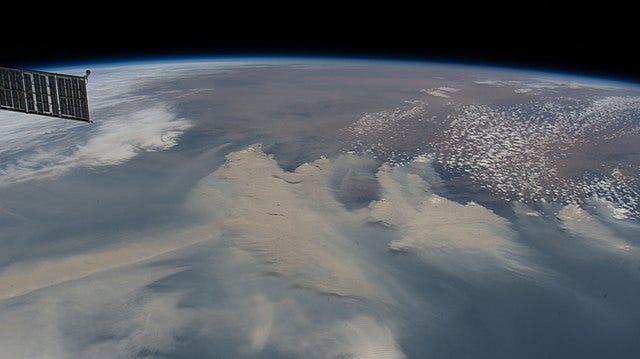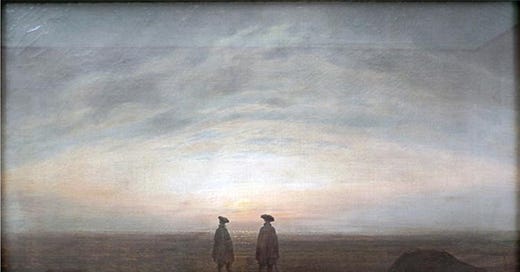
In 1817 the German landscape artist Caspar David Friedrich painted two men standing on a rocky beach. The men have their backs to us, their shoulders are slumped, and one has his head cocked to the side. Silhouetting their forms, an orangish-white smudge of sunlight surrenders to the gray fog and casts a weak glow on the slate sea.
Friedrich’s 1817 painting Two Men by the Sea stands in grim contrast to his 1810 Landscape with Rainbow, where warm yellow sunlight cast shadows on a verdant valley. The change in the light wasn’t just a mood swing for the Romantic oil painter. The sun really did go dim across the planet for several years after Mount Tambora erupted in the Dutch East Indies in April 1815.
The eruption was the largest in recorded history, immediately reducing the enormous Mount Tambora in size by two-thirds. Pyroclastic flows of lava and gas destroyed entire villages and stripped vegetation off the island of Sumbawa, while the seismic jolt triggered a tsunami up to 13 feet high that swept the Indonesian archipelago and left thousands dead. That was just the beginning.
Sulfur dioxide from the eruption reached the stratosphere and spread worldwide, causing a persistent “dry fog” that obscured the sun. Average global temperatures dropped between 0.4 and 0.7 degrees Celsius, leading to a deadly famine in China and food riots as crops failed in Europe.
In Albany, New York, snow fell in June 1816, adding a surreal punchline to the Year Without a Summer. For years afterward, around the world, even straightforward paintings of sunsets and natural vistas took on shades of apocalypse. 1
Our climate fates are tied to the fates of people on the other side of the world. We have the capacity to understand this reality better now than in the early 19th century, but we live in denial until our own valleys are flooded and our own pantries are empty. I was thinking about our interconnection again this week in a different context after reading two news items. Both of them had to do with the prospect of nuclear war.
One: An Aug. 8 FBI raid on Donald Trump’s Florida home, the Mar-a-Lago resort in Palm Beach, sought to recover documents related to nuclear weapons that the former president evidently kept after leaving office. It’s anybody’s guess at this point what he was doing with them, but what’s clear is that these documents were just kind of loose for the past year-and-a-half.
Two: A new peer-reviewed study in the journal Nature Food predicts that a modern nuclear war could result in more than 5 billion deaths worldwide — not from the explosions or the immediate radioactive fallout, but from disruptions to global food production during years of nuclear winter. 2
To make their predictions, the team of researchers considered two likely scenarios: a week-long nuclear war between India and Pakistan, and a week-long nuclear war between the United States and Russia. Their computer models accounted for modern nuclear and thermonuclear weapons, which could produce explosive yields more than 60 times the size of the last U.S. detonation on civilians in Nagasaki, Japan. 3
This is from the paper:
In a nuclear war, bombs targeted on cities and industrial areas would start firestorms, injecting large amounts of soot into the upper atmosphere, which would spread globally and rapidly cool the planet. Such soot loadings would cause decadal disruptions in Earth’s climate, which would impact food production systems on land and in the oceans …
A war between India and Pakistan, which recently are accumulating more nuclear weapons with higher yield, could produce a stratospheric loading of 5–47 Tg of soot. A war between the United States, its allies and Russia—who possess more than 90% of the global nuclear arsenal—could produce more than 150 Tg of soot and a nuclear winter. While amounts of soot injection into the stratosphere from the use of fewer nuclear weapons would have smaller global impacts, once a nuclear war starts, it may be very difficult to limit escalation.
For one recent point of comparison, the researchers mention the catastrophic forest fires in Canada (2017) and bush fires in Australia (2019-2020), which produced between 0.006 and 0.02 teragrams of soot. Across the planet, the soot clouds were visible from space for months afterward.

A U.S.-Russian nuclear exchange could release about 7,500 times that amount of soot into the upper atmosphere. Crops and fisheries would fail. Billions of people would not have access to enough calories and protein to survive. 4
The list of assumptions that went into the researchers’ predictions is dire. Among other things, they assume:
All stored food would be consumed by the end of Year 1 following nuclear war, after which point we would have to survive on whatever new crops, livestock, and fish we are able to harvest
All international food trade would halt, causing mass starvation in countries dependent on food imports
In order to survive, a country would need to maintain enough caloric intake for underweight people to continue carrying on productive labor
Some countries could reduce the death toll by taking grain produced for livestock feed and giving it to humans for food instead, but this would depend on a top-down reorganization of agriculture for survival rather than commodity production
Total calories would be evenly distributed within each nation
The researchers acknowledge that the last assumption is more than a little naive. They write:
In 2020, 720 million-811 million people suffered from undernutrition worldwide, despite food production being more than sufficient to nourish a larger world population. Thus, it is likely that food distribution would be inequitable both between and within countries.
Even with this study, the researchers are not taking into account the potential death toll from resource wars, mass refugee camps, radiation poisoning, soil contamination, birth defects, extreme weather exposure, ruined infrastructure, or pollinator extinctions. They are modestly trying to understand how the sheer quantity of soot kicked up by an exchange between nuclear powers would affect our species’ ability to obtain food.

I’d encourage you to read the whole paper if you get a minute this week. It’s pretty accessible until it gets to the hard math; you can get a good idea of its practical implications even if you’re a layman like me. Among other things, I’ve been reflecting on how even the phrase “nuclear annihilation” is wishful thinking. If modern thermonuclear weapons are deployed anywhere on earth, most of us will not be burned up in an instant — we will die slowly amid unimaginable torment and unprecedented conflict over the course of years or decades.
Our imaginations are not primed for these scenarios like they were during the peak of the Cold War. Back in 1984, a team from the BBC used the limited predictive models available at the time to produce Threads, a dramatization of a hypothetical nuclear strike in the city of Sheffield. It is the most terrifying film I have seen, and many of its predictions hold true under the latest predictive models.
Shortly after the bombs fall in Threads, municipal officials and military leaders are huddled in a basement beneath Sheffield’s brutalist town hall. They have control over some strategic food reserves, but they know they won’t last long.
“And now they're coming out of the shelters,” a medical official says. “I know it sounds callous, but I think we should hang on to the little food we've got.”
Another officer pipes up: “And I need that food to force people to work.”
If a nuclear war begins, the mushroom clouds are just the beginning of the hell to come. Humans will limp on afterward, surviving or not surviving under a dimmed sun.
***
One article I appreciated this week was Kelsey Atherton’s “Atomic Mass.” It’s about the state of the nuclear disarmament movement in New Mexico, the still-beating heart of the U.S. nuclear-military-industrial complex. You can read it here.
I recently had a new piece published in Jacobin. It’s an interview with Aneil Tripathi, a 19-year-old Starbucks employee who helped organize the first unanimous union vote at a Starbucks in the American South. Aneil and his coworkers in Anderson, South Carolina, are currently fighting some union-busting tactics that are extreme even by Howard Schultz’s standards. The title of the piece is “Starbucks Is Accusing Me and My Coworkers of Kidnapping Our Boss.”
Brutal South is a free newsletter about education, class struggle, and religion in the American South. If you would like to support my work, get some cool stickers in the mail, and read / listen to some subscriber-only content, paid subscriptions are $5 a month.
Bookshop // Twitter // Bandcamp // Apple Podcasts // Spotify Podcasts
To see some more paintings from the aftermath of Mount Tambora’s eruption, check out Hubbard, Z. (2019). Paintings in the Year Without a Summer. Philologia, 11(1), 17–33. http://doi.org/10.21061/ph.173
Xia, L., Robock, A., Scherrer, K. et al. Global food insecurity and famine from reduced crop, marine fishery and livestock production due to climate disruption from nuclear war soot injection. Nat Food (2022). https://doi.org/10.1038/s43016-022-00573-0
From Scientific American: in March: “In the United States’ current nuclear arsenal, the most powerful bomb is the B83, which has a maximum yield of 1.2 megatons, making it 60 times more powerful than the bomb dropped on Nagasaki, Japan, in 1945. According to the Nuclear Weapon Archive, 650 B83s are in ‘active service.’”
The research team uses several advanced computer models to make its predictions, including the National Center for Atmospheric Research’s Whole Atmosphere Community Climate Model (WACCM), Community Earth System CLM5 land models, and the BiOeconomic mArine Trophic Size-spectrum (BOATS) model for global fish populations and fisheries. These models have their limitations, including the fact that they were designed to model the effects of global warming, not global cooling. For example, CLM5crop only models changes in spring wheat production and cannot predict changes in winter wheat production.




Zwei Manner am Meer (Two Men by the Sea) is eerily beautiful. Beautiful in the way that the artist is able to portray the scene and get feeling across to the viewer. Eery in that it is true and natural disasters are more prevalent than ever..